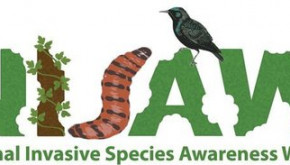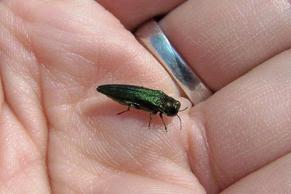
by the Maine Department of Agriculture, Conservation and Forestry
Did you know that it is National Invasive Species Awareness Week THIS WEEK?
10 Ways to Observe National Invasive Species Awareness Week
in Maine
February 25 - March 3, 2019
 |
Emerald ash borer adult. Photo by Marianne Prue, Ohio Department of Natural Resources
1. Learn how to identify invasive plants that might be growing on your property. With the leaves off the trees, now is a great time to find some invasive plants that might otherwise be hidden, such as Asiatic bittersweet vines snaking through a tree’s canopy. Take a walk through your property and flag woody invasive plants. Map your finds using iMapInvasives and plan your management tactics for each species.
2. Be on the lookout for the invasive Tree of Heaven, which is host to a new invasive insect threat, the spotted lanternfly. If you think you have seen Tree of Heaven, please report it to [email protected].
3. Learn how to identify signs of emerald ash borer. Wintertime is a great time to see “blonding” on ash trees, the shallow flecking of the bark by woodpeckers. If you think you see “blonding”, take some good quality photos, note your location, and report your findings on the EAB Report Form.
4. Go for a wooded hike and look for signs of other invasive forest insects. Use this handy guide from the Maine Forest Service to help. Make it a family, club or organization outing! Become a citizen scientist and report your findings to Vital Signs.
5. Planning a camping trip? Leave your firewood at home and prevent the spread of invasive pests. Buy firewood at the campground or go to FirewoodScout.org to find other local sources.
6. Play-Clean-Go! Clean hiking boots, waders, boats and trailers, off-road vehicles and other gear to stop invasive species from hitching a ride to a new location. Learn more at PlayCleanGo.org
7. CLIP THOSE WINTER WEBS! For those of you in browntail moth territory, now is a great time to clip out the webs of overwintering browntail moth caterpillars before they become active. Learn more here.
8. Help protect Maine’s waterways from invasive aquatic plants by following Clean, Drain, Dry Help further and consider joining the Lake Stewards of Maine, the longest-standing, state-wide citizen lake monitoring program in the U.S.
9. Don't release aquarium fish and plants, live bait or other exotic animals into the wild. If you plan to own an exotic pet, do your research and make sure you can commit to its care. Learn more at habitattitude.net.
10. Spread Awareness: take your National Invasive Species Awareness Week commitment beyond this week. Tell your friends, family, neighbors and others about invasive species! It’s a big state and we can't get the word out to everyone without your help. Encourage them to get involved with National Invasive Species Awareness Week in their own way. Here are some resources to help get started:
- Like or Follow Maine Invasive Species Network Facebook page
- Like or Follow Maine Bug Watch Facebook page
- Learn more about Invasive Species Programs run by the State of Maine
 |
Invasive Milfoil in Winthrop Pond, Photo by DEP.

